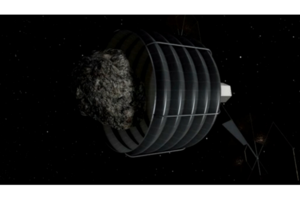NASA wants to lasso an asteroid, but which one?
NASA scientists have identified a dozen or so space rocks for its asteroid-retrieval mission, which it hopes to accomplish by 2025.

In this still from a NASA video, a robotic spacecraft's capture bag swallows an asteroid in order to return it to Earth. NASA plans to retrieve an asteroid and park it near the moon by 2025, possibly even by 2021, so astronauts can explore it.
NASA
NASA is making progress on one of the most challenging parts of its ambitious asteroid-retrieval mission — finding a suitable space rock to shrink-wrap in space.
Scientists have identified a dozen or so promising targets for NASA's asteroid-capture mission, which seeks to drag a small rock — or a piece of a larger one — into a stable orbit around the moon, where it would be visited by astronauts by 2025.
"For either concept that's being looked at right now — either the capture of a small asteroid less than 10 meters in size, or going after a boulder, large boulder, on a larger asteroid — we have a list of about six or so candidates each," Lindley Johnson, program executive for NASA's Near-Earth Object (NEO) Observations Program, told reporters Friday (March 21). [NASA's Asteroid-Capture Mission in Pictures]
"We continue to look for additional candidates," Johnson said, adding that NEO program scientists "will continue to do that over the next two to three years, until the time comes to actually determine which will be the best object for the mission."
The NEO program's primary purpose is identifying and tracking potentially dangerous asteroids. But good capture candidates are a subset of this larger group, Johnson said, so assessment of their suitability for the redirect mission doesn't take NEO scientists too far afield.
The asteroid-redirect mission would use a robotic probe to move the targeted space rock into Earth-moon space. The asteroid would then be visited, perhaps multiple times, by astronauts using NASA's Orion capsule and Space Launch System rocket, which are slated to fly crews together for the first time in 2021.
NASA wants the first manned visit to the retrieved asteroid to come around 2025, which would mesh well with an exploration timeline laid out by the White House. In 2010, President Barack Obama directed NASA to get astronauts to a near-Earth asteroid by 2025, then on to the vicinity of Mars by the mid-2030s.
The mission will serve as a stepping stone, NASA officials have said, demonstrating technologies that will allow humanity to reach Mars and other destinations in deep space. It will also advance scientists' understanding of the early solar system and help develop asteroid-mining technology and know-how, advocates say.
On Friday, NASA announced that it is seeking innovative ideas that could help take the asteroid-capture mission from concept to reality. The space agency will select up to 25 proposals and dole out a maximum of $6 million dollars, with the awards expected to be announced on July 1.
The space agency hopes to have a basic mission concept in place by around the end of the year, officials said today, though some components of the architecture may be changed, added or refined thereafter.
Follow Mike Wall on Twitter @michaeldwall and Google+. Follow us @Spacedotcom, Facebook or Google+. Originally published on Space.com.
- How to Catch an Asteroid: NASA Mission Explained (Infographic)
- Animation Of Proposed Asteroid Retrieval Mission | Video
- Potentially Dangerous Asteroids (Images)
Copyright 2014 SPACE.com, a TechMediaNetwork company. All rights reserved. This material may not be published, broadcast, rewritten or redistributed.

